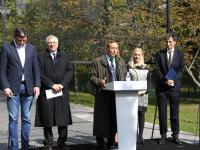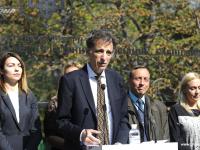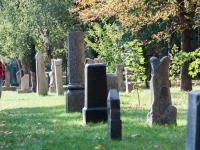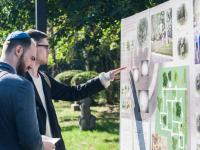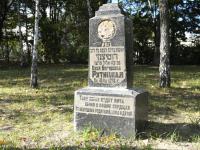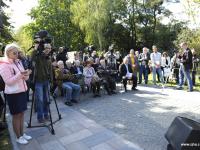These days, 76 years after the tragedy of Babyn Yar, in the capital of Ukraine marks the peak of mass executions of the Jewish population of Kyiv. Here, in 1941, only for two days, on September 29 and 30, Nazis killed almost 34 thousand people. In total, according to various estimates, from 1941 to 1943, more than 100 thousand people were shot at this place.
To the anniversary of tragic events, the National Historical-Memorial Reserve "Babyn Yar" presented Lapidarim from the grave monuments of the former Lukyanivka Jewish cemetery, found in the Repyahov ravine.
The presentation was attended by Ambassador Extraordinary and Plenipotentiary of the State of Israel to Ukraine Eliav Belotserkovsky, Deputy Minister of Culture of Ukraine Tamara Mazur, Director General of the National Historic-Memorial Reserve "Babyn Yar" Boris Glazunov, CEO, BYHMC Marek Siwiec, Director of the Culture Department of the Kyiv City State Administration Dina Popova, Head of the Shevchenkivskyi District State Administration in Kyiv, Oleg Garyaga and representatives of the Jewish community in Kyiv.
"For history, not only the process of its preservation but also the restoration of lost is important. If our memory of the past is with us - this is the foundation of historical justice, then the creation of Lapidaria can be called one of the steps along this path ", said Boris Glazunov, Director General of the National Historic and Memorial Reserve.
Israeli Ambassador Eliav Belotserkovsky said that the cemetery, which tombstones are now being restored, was "one of the centres for the memory of the prosperous Jewish community of Kyiv at the turn of the 19th and 20th centuries."
"All these famous people symbolize the flowering culture, which, unfortunately, it was almost completely destroyed as a result of the Nazi invasion." Millions of Jews who were killed by the Nazis and their supporters did not find either their own grave or their own tombstone, they remained in mass graves at the bottom of the ditches. So, to honour their memory, having installed in Babyn Yar gravestones from the Lukyanivka Jewish cemetery, has a deep symbolism: they seem to be re-posthumous to join the Kyiv Jewish community, unite with their predecessors and with the memory of descendants"- said Eliav Belotserkovsky.
LUKYANIVKA JEWISH CEMETERY: RETURN FROM OBLIVION.
The culture of the people is the heritage of generations that can not exist without the experience of the past. It is based on the collective experience of the people, mankind, its knowledge, skills, traditions. It is inherent for a man to store the past in memory and pass it on to the next generation. Here there is a deep and direct spiritual contact of a person with a history.
Historical landscape of Ukraine XVI-XIX centuries is known for the diversity of ethnic and religious denominations of its inhabitants: Ukrainians, Poles, Jews, Germans, Russians, Tatars, Armenians and others lived for centuries together. Catholics, Orthodox, Protestants, Jews and Muslims brought here their cultural and artistic traditions and over time took over the experience of their neighbours. This mutual interweaving of cultures at that time was the basis of the specific atmosphere of the city. One of the important and extremely interesting carriers of the culture of every nation is the cemetery. In many countries with a long-standing culture, visits to burial grounds are no less important than a meeting with their contemporaries. After all, cemeteries are an integral part of life and evidence of what happened once in the territory of our region - they are open-air museums. They remind of outstanding people and inform us about historical events, draw the attention of visitors to the building, cultural and artistic peculiarities of different eras; link past, present and future; they show mentality, customs and traditions, and, of course, people's faith. They kept the secrets of native culture. There is a great interest in this heritage, as well as in its research and scientific study, since the features of culture, customs, traditions, funeral rituals of Jews, an organization of a cemetery are still little known to the public. Cemeteries in cities and towns of Ukraine had their own peculiarities. They played a significant role in identifying the national composition of the city, determining the dimensions of the Jewish population. As you know, far from every Jewish community has the right to retain its cemetery. The problem of its appearance in the city depended on the will of the owner of the city and, as a rule, until the beginning of the XVIII century. in most cities of Ukraine has found its solution.
For the first time in the Ukraine, Jews first gained privileges that guaranteed the inviolability and protection of their cemeteries in accordance with the Kaliski statute issued by Bolesław Pobożny ( Bolesław Pobożny) in 1264.
The funeral of the Jews was strictly regulated. Each community had its own funeral brotherhood, Hevra Kaddish, which included the most worthy members of the community and was actively involved in the organization of the funeral and the settlement of all formalities associated with this sad event. The cemeteries also had their own internal order and established rules of care.
It is believed that the old Jewish cemeteries have gone away forever. After all, if there are no custodians of culture - there are no cemeteries themselves. Yet the Jewish cemetery continues to perform its function, even if there are no new burials on it. After all, the elimination of the territory of the cemetery and the absence of its external attributes: tombstones, fences, matsevas, does not mean the disappearance of the cemetery since the burials remained underground. Therefore, the assertion that cemeteries, which are "not used" or "non-operating", are "abandoned" or "former Jewish cemeteries" is false. According to the religious traditions of the Jews, the reburial of the dead or the transfer of the cemeteries is impossible. Because of this requirement that Jewish cemeteries are different from Christian ones, who are always "active" and consequently the next generation cares about their predecessors.
The Lukianiv Jewish Cemetery began to operate in 1894. It occupied a considerable space in the empty area, limited by the Dorogozhitska Street, the slopes of the Repyahiv and Babyn ravines, and the boundary of the Cyrillic Orthodox Cemetery, which was attached to the Church of the Cyril and the Hospital. Many prominent Jewish figures were buried in the area of this necropolis.
After the revolution 1917, the "boundary of settlement", which restricted Jews' rights to live in Kyiv, vanished. The Jewish community of Kyiv increased. But the revolution was at the same time the beginning of a total offensive against the religion, in particular, Jewish religion and tradition. It also concerned the funeral rites. On June 1, 1919, a decree was signed by the People's Commissar of the Ukrainian SSR X. Rakovsky "On Cemeteries and Funerals". He proclaimed that "all cemeteries, morgues and crematoria, as well as the organization of the funeral of citizens, enter into the management of local councils, departments of communal services." As soon as the decree came into force, Kyiv municipal services stopped the activities of Jewish burial structures. This caused an outbreak of indignation among believing Jews. There were cases of delays in burials.
The total area of the Lukianivka Jewish Cemetery, according to the statistical survey of the Kiev cemeteries (1929), amounted to 23.3 hectares.
Throughout the years 1941-1943, the terrible massacres of Soviet citizens (in particular, Jews and Roma) were committed by Nazi occupiers on the territory of the cemetery and nearby Babyn Yar. It is known that prisoners of the Syrets concentration camp used the monuments and metal fences from the Jewish cemetery to arrange furnaces for burning bodies of the dead in Babyn Yar.
In the postwar years, the cemetery was in an abandoned state. However, on its territory, there were thousands of graves and burial vaults (the scale of these structures can be seen on the basis of photographs of 1953). The final decision on the destruction of this necropolis was taken by the city executive committee on June 26, 1962. The resolution stated that the total territory of the cemetery with the area of 26.9 hectares should be "transferred to the Office of the Green Zone for the formation of a park and recreation park", which citizens are requested to transfer the burial place to other cemeteries, and "tombstones that will remain impassable (monuments, slabs, fences etc.) after January 1, 1963, to take off. The decision was motivated by the allegation that cemetery "Old Jewish - Karaim, located on the street. Melnikov, No. 82-86, closed in 1937 and now turned into overgrown wild shrubs, and most of the tombstones were destroyed during the German occupation. " In fact, there is evidence (in particular, in the essay of the famous writer Viktor Nekrasov) that the systematic destruction of graves at the cemetery was carried out in post-war years. "It is known that the Germans destroyed a central alley in the impulse of blind malice. To destroy remainder, they did not have enough strength and desire. The rest was committed later. By whom? Nobody knows or everybody keeps silent. This work was systematic, conscious. With the use of technics. Without a bulldozer or tractor, or even a tank, you will not carry out this." Eventually, according to available information, about 1500 graves were transported from the Jewish cemetery, other tens of thousands of gravestones were destroyed or utilized. Separate remains of burial slabs and monuments till this day can be found on the slopes of the Repyakhiv Yar.
During May-August 2017, employees of the National Historical-Memorial Reserve "Babyn Yar" (Glazunov B.I., Director General of the Reserve; Tkachuk A.P.; Deputy Director General for Scientific Work; Lytvyn I. I., Deputy Director General of General issues; Gutor M.S., Head of the Archival Department; Korneluk V.P., Senior Researcher; S.S. Palamar, Senior Researcher; .Zolotarenko A., Head of the Department, "Babyn Yar Museum"; Strahovchuk O.Y., Head of the Department of Containment; Bondar S.V, an employee of the Accomplishment Department), 45 memorial slabs and tombstones were excavated from the bottom and slopes of the Repyakhiv Yar. The memorials pulled out from the ravine were cleared and washed away from the dirt and exhibited along the Road of Sorrow, which leads from the building of the former office of the Jewish cemetery on the street. Melnikova, 44, to the memorial sign "Menorah". The work will be continued.
Thus, on the territory of the National Historical and Memorial Reserve "Babyn Yar," it was started the creation of the Lapidarium of the memorial slabs and gravestones of the former Lukyanivsky Jewish cemetery, which was a dumb witness to the tragic events in Babyn Yar.







